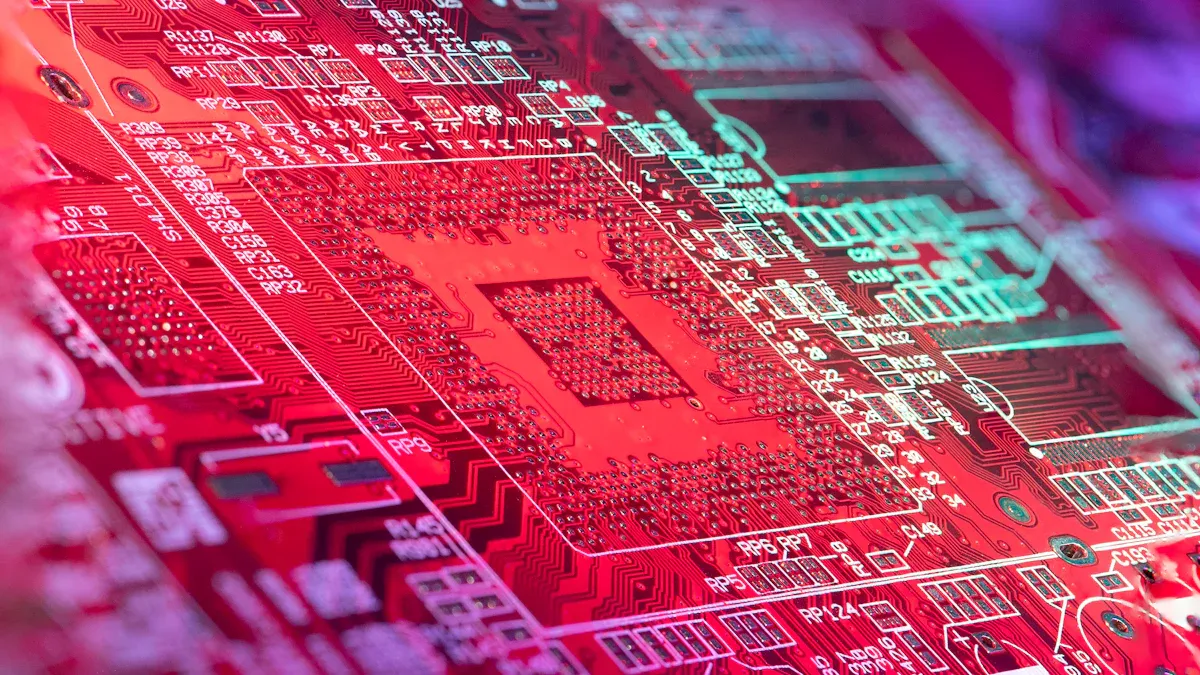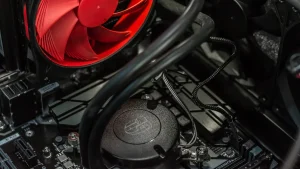
Selecionar a direita semiconductor coating is crucial for optimizing the performance of silicon semiconductor equipment. Revestimento TaC e Revestimento SiC stand out due to their advanced thermal resistance and chemical stability. These properties enable them to endure extreme conditions, such as thermal shock, which can compromise other materials. For instance, analyzing the flexural strength of flame-sprayed alumina coatings reveals their susceptibility to thermal shock, as indicated by a lower Weibull modulus compared to hot-isostatic pressed alumina. This underscores the importance of choosing coatings with superior thermal properties. Understanding the advantages of the TaC Coating and the SiC Processo de revestimento is essential for ensuring reliability in demanding environments.
Tiras de Chaves
- TaC Coating works well in very high heat and resists chemicals. It is great for tough semiconductor jobs.
- SiC Coating handles heat well and does not react with chemicals. It is a cheaper option for spreading heat efficiently.
- Picking the right coating depends on needs like heat levels and chemical contact. This helps things work their best.
- Both coatings can be adjusted to fit special needs. This improves how well they work in semiconductor tasks.
- Spending more on good coatings like TaC can save money later by needing less fixing.
Revestimento TaC

Key Properties
TaC Coating, or Tantalum Carbide Coating, is renowned for its exceptional thermal and chemical properties. It boasts one of the highest melting points among advanced ceramics, exceeding 3,800°C. This makes it highly resistant to extreme temperatures. Its chemical inertness ensures stability in corrosive environments, including exposure to halogen gases and plasma. Additionally, TaC Coating exhibits remarkable hardness, with a Vickers hardness value of approximately 1,880 HV, which enhances its durability against mechanical wear.
The coating also demonstrates excellent electrical conductivity, a unique feature among ceramic materials. This property allows it to perform effectively in applications requiring both thermal and electrical stability. Furthermore, its low thermal expansion coefficient minimizes the risk of cracking under rapid temperature changes, ensuring long-term reliability.
Advantages for Semiconductor Equipment
TaC Coating offers several advantages for semiconductor manufacturing processes. Its ability to withstand extreme temperatures makes it ideal for high-temperature applications, such as chemical vapor deposition (CVD) and plasma etching. The coating’s chemical resistance ensures that it remains stable when exposed to aggressive chemicals, including fluorine-based plasmas commonly used in semiconductor fabrication.
The hardness of TaC Coating provides superior protection against physical wear, extending the lifespan of critical components like wafer carriers and susceptors. Its electrical conductivity also supports its use in electrostatic chuck applications, where precise control of electrical properties is essential. Moreover, the coating’s low thermal expansion reduces the likelihood of thermal stress, ensuring consistent performance in demanding environments.
Limitações
While TaC Coating excels in many areas, it is most effective in specific applications requiring extreme thermal and chemical resistance. Its high-performance characteristics may not be necessary for less demanding environments, where alternative coatings could provide a more cost-effective solution. Additionally, the application process for TaC Coating requires advanced techniques to ensure uniformity and adhesion, which may increase production complexity.
Revestimento SiC

Key Properties
Silicon Carbide (SiC) Coating is widely recognized for its exceptional thermal and mechanical properties. It exhibits high thermal conductivity, with values reaching approximately 90 W·m⁻¹·K⁻¹ at room temperature, significantly outperforming pyrocarbon coatings. This superior thermal management capability makes SiC an excellent choice for applications requiring efficient heat dissipation. Additionally, SiC demonstrates a low coefficient of thermal expansion, measured at 4.5 x 10⁻⁶ °C between 20°C and 400°C, which minimizes thermal stress and enhances structural stability under fluctuating temperatures.
The material’s durability stems from its high Debye temperature, which indicates a smaller thermal expansion coefficient compared to transition metal carbides. This property ensures long-term reliability in high-temperature environments. Furthermore, SiC Coating achieves a purity level of 99.9995%, ensuring minimal contamination in sensitive semiconductor processes. Its theoretical density of 3.21 g/cc contributes to its robust mechanical strength, while its maximum operating temperature of up to 1700°C underscores its suitability for extreme conditions.
Advantages for Semiconductor Equipment
SiC Coating offers numerous benefits for semiconductor manufacturing, particularly in applications requiring thermal stability and chemical resistance. Its high thermal conductivity ensures efficient heat dissipation, reducing the risk of overheating in critical components. This property is especially valuable in high-power devices and thermal management systems. The coating’s low thermal expansion coefficient further enhances its performance by preventing thermal stress, which can lead to cracking or deformation.
The material’s chemical inertness provides excellent resistance to corrosive environments, including exposure to reactive gases and plasma. This makes SiC Coating ideal for components such as process chambers, wafer carriers, and susceptors. Additionally, its high purity level minimizes the risk of contamination, ensuring the integrity of semiconductor wafers during fabrication. The coating’s mechanical strength and durability extend the lifespan of equipment, reducing maintenance costs and downtime.
| Propriedade | Valor |
|---|---|
| Coeficiente de expansão térmica | 4.5 x 10⁻⁶ °C (20°C – 400°C) |
| Condutividade térmica | 250 W/m-K (at 20°C) |
| Temperatura máxima de operação | Up to 1700°C |
| Purity Level | 99.9995% |
| Theoretical Density | 3.21 g/cc |
Limitações
While SiC Coating excels in many areas, certain limitations should be considered. Its performance characteristics are based on mono-centric data from non-randomized observational studies, which may not fully represent all industrial scenarios. Additionally, the coating’s effectiveness in specific applications may vary, as no evidence suggests that alternative materials could not achieve similar results. These findings highlight the need for further research and larger randomized trials to validate its performance across diverse conditions.
Comparative Analysis
Performance Comparison
When comparing TaC Coating and SiC Coating, their performance metrics reveal distinct strengths tailored to specific applications. TaC Coating demonstrates exceptional hardness and elastic modulus, making it ideal for environments requiring extreme durability. SiC Coating, on the other hand, offers balanced mechanical properties and excels in thermal management.
The table below highlights the hardness and elastic modulus of both coatings under standard industrial tests:
| Tipo de revestimento | Dureza (GPa) | Elastic Modulus (GPa) |
|---|---|---|
| ta-C (Si 1.25 at.%) | 41 | 522 |
| ta-C (Si 3.85 at.%) | 33 | N/A |
| ta-C (Si 6.04 at.%) | 23 | 328 |
| SiC | 27 | 315 |
The chart below visually compares these properties, emphasizing the superior hardness of TaC Coating in specific configurations:

These results demonstrate that TaC Coating outperforms SiC Coating in hardness and elastic modulus, making it a preferred choice for high-stress applications. SiC Coating, however, provides sufficient mechanical strength for most semiconductor processes while offering additional benefits like high thermal conductivity.
Cost and Maintenance
Cost and maintenance considerations often influence the choice between TaC Coating and SiC Coating. TaC Coating, due to its advanced properties and specialized application process, typically incurs higher initial costs. However, its durability and resistance to wear can reduce long-term maintenance expenses. SiC Coating, being more cost-effective upfront, appeals to manufacturers seeking a balance between performance and budget. Its lower maintenance requirements further enhance its appeal for less demanding applications.
Application-Specific Recommendations
Selecting the right coating depends on the specific requirements of the semiconductor equipment. TaC Coating is highly recommended for high-temperature environments, such as chemical vapor deposition and plasma etching, where extreme thermal and chemical resistance is essential. SiC Coating, with its excellent thermal conductivity and chemical inertness, is better suited for applications requiring efficient heat dissipation and minimal contamination, such as wafer carriers and process chambers. Manufacturers should evaluate their operational needs to determine the most suitable solution.
TaC Coating and SiC Coating provide distinct advantages for semiconductor manufacturing. TaC Coating excels in high-temperature and chemically aggressive environments, offering unmatched durability and thermal resistance. SiC Coating, on the other hand, delivers a cost-effective and versatile solution with excellent thermal conductivity and chemical inertness. Both coatings cater to specific operational needs, ensuring optimal performance in demanding applications.
Ningbo VET Energy Technology Co. specializes in advanced ceramic solutions, delivering tailored products that meet the rigorous demands of modern semiconductor equipment. Their expertise ensures reliable and efficient manufacturing processes.
FAQ
What factors should manufacturers consider when choosing between TaC and SiC coatings?
Manufacturers should evaluate operational requirements, including temperature range, chemical exposure, and mechanical stress. Revestimentos TaC excel in extreme thermal and chemically aggressive environments, while SiC coatings offer superior thermal conductivity and cost-effectiveness. Matching the coating properties to specific application needs ensures optimal performance and longevity.
How does the application process differ for TaC and SiC coatings?
TaC coatings require advanced techniques to ensure uniformity and adhesion due to their high melting point. SiC coatings, while also requiring precision, involve processes optimized for thermal conductivity and purity. Both demand expertise to achieve consistent quality and performance in semiconductor applications.
Are TaC and SiC coatings environmentally sustainable?
Both coatings contribute to sustainability by extending the lifespan of semiconductor equipment, reducing waste and resource consumption. Their chemical stability minimizes contamination risks, supporting cleaner manufacturing processes. However, the production and application processes should align with environmental standards to ensure overall sustainability.
Can TaC and SiC coatings be customized for specific applications?
Yes, both coatings can be tailored to meet unique operational demands. Manufacturers can adjust thickness, purity, and application methods to optimize performance for specific environments. Customization ensures compatibility with diverse semiconductor processes, enhancing efficiency and reliability.
What industries benefit most from TaC and SiC coatings?
The semiconductor industry is the primary beneficiary, but other sectors like aerospace, automotive, and energy also utilize these coatings. Their exceptional thermal and chemical properties make them valuable for high-performance applications requiring durability and precision.






